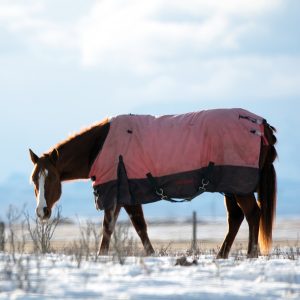
7 feeding tips to help your horse get through the cold winter months
Winter is coming. Are you ready?
1) Have a good supply of hay.
Ensure you have an adequate supply of good quality hay to last through the winter months. If you are purchasing and storing hay, keep it in a dry place out of direct sunlight. Learn more at https://kppusa.com/2017/11/01/preparing-feed-room-hayloft-winter/
2) Supplement vitamins missing from winter pasture and dried forages.
In the winter months, supplemental vitamins will be required once the pasture grasses stop growing. Natural vitamin E is the most commonly deficient vitamin in horses eating hay and/or grazing on winter pasture. Start supplementation 30 days before grasses go dormant and continue through the winter.
3) Transition from pasture to hay slowly.
As pastures fade in the fall, begin to feed additional hay slowly. Start with a flake per horse per day and slowly increase the amount fed over two weeks. It takes the horse’s digestive tract about two weeks to acclimate to a new forage type. If the quality of the pasture is good, you may need less supplemental hay. If your pastures are heavily grazed you may need to start putting out hay earlier. Supplementing with a well-formulated digestive supplement can ease the stress of seasonal changes on the gut. Begin supplementation two weeks before you start your transition period.
4) Offer additional hay when temps drop.
The best way to keep horses warm when the temperature drops is to feed additional forage.
Horses begin to struggle to keep warm below certain critical temperatures. For a clipped horse, the critical temperature is 41°F (5°C). For a horse with a thick winter coat, the critical temperature is 18°F (-8°C). An easy guideline to follow is that a sedentary mature horse will need 2% more high-quality forage for every degree the temperature falls below the lower critical temperature. Small or older horses will be less tolerant of cold temperatures. Begin to feed additional forage at least 24 hours prior to periods of extreme cold or winter storms.
5) Avoid winter weight loss by increasing calorie intake.
As temperatures fall, your horse’s energy requirements increase. Hard keepers will mostly likely need more calories than a regular diet of forage and concentrate can provide. Adding a high-fat supplement to your horses’ diet will stop winter weight loss so your horses look great in the spring. Learn more at https://kppusa.com/2018/10/24/skinny-fat/
6) Ensure your horse is drinking enough water in the cold weather.
Horses need to drink a minimum of 10 to 12 gallons of water a day to stay healthy. Their requirements increase if they are ridden. The ideal temperature for drinking water is between 45°F and 65°F. Offer warmer water to horses that are older and may have sensitive teeth, are drinking less than normal amounts, or those with a history of impaction. Learn more at https://kppusa.com/2016/01/25/3-easy-tips-ensure-horse-getting-enough-water-winter-2/)
7) Provide adequate levels of salt to stimulate drinking.
Salt stimulates the thirst response and helps keep horses drinking. At rest, a horse should be eating about 2 oz of salt per day, either in the feed or from a plain white salt block or loose salt. If your horse continues to work during the winter, supplement with a well-balanced electrolyte . Learn more at https://kppusa.com/2021/11/10/does-your-horse-need-electrolytes-during-the-fall-and-winter/)


